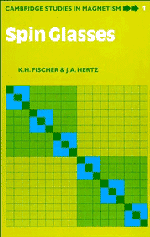Book contents
- Frontmatter
- Contents
- Preface
- 1 Introduction
- 2 Models, order parameters, and systems
- 3 Mean field theory I: Ising model, equilibrium theory
- 4 Introduction to dynamics
- 5 Mean field theory II: Ising dynamics
- 6 Mean field theory III: vector spins
- 7 Short-range interactions: low-temperature properties
- 8 Beyond mean field theory
- 9 Dynamics on many time scales
- 10 Specific heat, sound propagation, and transport properties
- 11 Competition between spin glass and ferromagnetic or antiferromagnetic order
- 12 One-dimensional models
- 13 Random field and random anisotropy
- 14 The physics of complexity
- 15 A short history of spin glasses
- References
- Index
4 - Introduction to dynamics
Published online by Cambridge University Press: 01 June 2011
- Frontmatter
- Contents
- Preface
- 1 Introduction
- 2 Models, order parameters, and systems
- 3 Mean field theory I: Ising model, equilibrium theory
- 4 Introduction to dynamics
- 5 Mean field theory II: Ising dynamics
- 6 Mean field theory III: vector spins
- 7 Short-range interactions: low-temperature properties
- 8 Beyond mean field theory
- 9 Dynamics on many time scales
- 10 Specific heat, sound propagation, and transport properties
- 11 Competition between spin glass and ferromagnetic or antiferromagnetic order
- 12 One-dimensional models
- 13 Random field and random anisotropy
- 14 The physics of complexity
- 15 A short history of spin glasses
- References
- Index
Summary
So far we have considered only the statics of spin glasses. However, the nonergodicity discussed in Sections 3.4 and 3.5 for the SK model suggests that the dynamics of spin glasses is rather unusual, at least below the freezing temperature. One expects transitions over energy barriers between the metastable states discussed in Section 3.5, leading to a new class of very slow relaxation times, some of which become infinite, at least in MFT. In this chapter we introduce the basic models and formal techniques necessary for describing the dynamics of spin glasses, corresponding to what we did for statics in Chapter 2. We focus on Ising systems here, both for the sake of simplicity and because, as we have mentioned, the anisotropic interactions found in most systems which one would expect to be Heisenberg spin glasses make them look rather Ising-like in many of their properties.
The Glauber model
The classical Ising model has no inherent dynamics, so to make a dynamical model one has to couple the spins to an additional ‘heat bath’ which induces spin flips (Glauber, 1963; Suzuki and Kubo, 1968). For metallic spin glasses this heat bath can be identified with the conduction electrons, which produce single-spin flip processes with the impurity spins via the exchange interaction Jsd. For a single magnetic impurity this leads to the so-called Korringa relaxation with relaxation time τ0.
- Type
- Chapter
- Information
- Spin Glasses , pp. 125 - 140Publisher: Cambridge University PressPrint publication year: 1991

